Alarm schematics
 This alarm circuit was designed to monitor a mains-powered smoke detector located in a shed (which is used to house dog kennels). It provides complete isolation from the mains so that low-voltage (12V) cabling could be run to the alarm circuit which is located inside the house. In operation, the alarm signal (I) from the smoke detector is rectified using bridge rectifier BR1 and then fed to optoiso lator OPTO1 via resistor R3. This in turn drives the gate of SCR1 which turns on and activates a piezo siren with inbuilt oscillator....
[read more]
This alarm circuit was designed to monitor a mains-powered smoke detector located in a shed (which is used to house dog kennels). It provides complete isolation from the mains so that low-voltage (12V) cabling could be run to the alarm circuit which is located inside the house. In operation, the alarm signal (I) from the smoke detector is rectified using bridge rectifier BR1 and then fed to optoiso lator OPTO1 via resistor R3. This in turn drives the gate of SCR1 which turns on and activates a piezo siren with inbuilt oscillator....
[read more]
 A complementary transistor pair (Q2 & Q3) is wired as a high efficiency oscillator, directly driving the loudspeaker. Q1 ensures a full charge of C2 when power is applied to the circuit. Pressing on P1, C2 gradually discharges through R8: the circuit starts oscillating at a low frequency that increases slowly until a high steady tone is reached and kept indefinitely. When P1 is released, the output tone frequency decreases slowly as C2 is charged to the battery positive voltage through R6 and the Base-Emitter junction of Q2. When C2 is fully charged the circuit stops oscillating, reaching a stand-by status....
[read more]
A complementary transistor pair (Q2 & Q3) is wired as a high efficiency oscillator, directly driving the loudspeaker. Q1 ensures a full charge of C2 when power is applied to the circuit. Pressing on P1, C2 gradually discharges through R8: the circuit starts oscillating at a low frequency that increases slowly until a high steady tone is reached and kept indefinitely. When P1 is released, the output tone frequency decreases slowly as C2 is charged to the battery positive voltage through R6 and the Base-Emitter junction of Q2. When C2 is fully charged the circuit stops oscillating, reaching a stand-by status....
[read more]
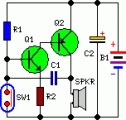 This circuit, enclosed in a small plastic box, can be placed into a bag or handbag. A small magnet is placed close to the reed switch and connected to the hand or the clothes of the person carrying the bag by means of a tiny cord. If the bag is snatched abruptly, the magnet looses its contact with the reed switch, SW1 opens, the circuit starts oscillating and the loudspeaker emits a loud alarm sound. A complementary transistor-pair is wired as a high efficiency oscillator, directly driving a small loudspeaker. Low part-count and 3V battery supply allow a very compact construction....
[read more]
This circuit, enclosed in a small plastic box, can be placed into a bag or handbag. A small magnet is placed close to the reed switch and connected to the hand or the clothes of the person carrying the bag by means of a tiny cord. If the bag is snatched abruptly, the magnet looses its contact with the reed switch, SW1 opens, the circuit starts oscillating and the loudspeaker emits a loud alarm sound. A complementary transistor-pair is wired as a high efficiency oscillator, directly driving a small loudspeaker. Low part-count and 3V battery supply allow a very compact construction....
[read more]
 Protect your valuable laptop against theft using this miniature alarm generator. Fixed in-side the laptop case, it will sound a loud alarm when someone tries to take the laptop. This highly sensitive circuit uses a homemade tilt switch to activate the alarm through tilting of the laptop case. The circuit uses readily available components and can be assembled on a small piece of Vero board or a general-purpose PCB....
[read more]
Protect your valuable laptop against theft using this miniature alarm generator. Fixed in-side the laptop case, it will sound a loud alarm when someone tries to take the laptop. This highly sensitive circuit uses a homemade tilt switch to activate the alarm through tilting of the laptop case. The circuit uses readily available components and can be assembled on a small piece of Vero board or a general-purpose PCB....
[read more]
 If you use a lamp with a motion sensor for outdoor lighting, the original electrical switch is actually no longer necessary. If you replace the switch with the circuit described here, an acoustical signal will be generated each time the outdoor lamp is switched on. It’s thus somewhere between an alarm and a doorbell. The operating principle is simple. A circuit that causes a voltage drop of only a couple of volts is connected in series with the lamp. As the circuit needs a DC voltage, the current for the lamp is passed through a bridge rectifier....
[read more]
If you use a lamp with a motion sensor for outdoor lighting, the original electrical switch is actually no longer necessary. If you replace the switch with the circuit described here, an acoustical signal will be generated each time the outdoor lamp is switched on. It’s thus somewhere between an alarm and a doorbell. The operating principle is simple. A circuit that causes a voltage drop of only a couple of volts is connected in series with the lamp. As the circuit needs a DC voltage, the current for the lamp is passed through a bridge rectifier....
[read more]
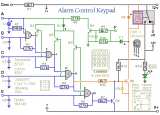 This Keypad is suitable for the Modular Burglar Alarm. However, it has other applications. Entering the First Four Digits of your chosen Five-Digit code - will energize the relay. Entering the Full Five-Digit code - will de-energize it....
[read more]
This Keypad is suitable for the Modular Burglar Alarm. However, it has other applications. Entering the First Four Digits of your chosen Five-Digit code - will energize the relay. Entering the Full Five-Digit code - will de-energize it....
[read more]
 This Keypad is suitable for the Modular Burglar Alarm. However, it has other applications. Pressing a single key will energize the relay. Entering the Four-Digit code of your choice will de-energize it....
[read more]
This Keypad is suitable for the Modular Burglar Alarm. However, it has other applications. Pressing a single key will energize the relay. Entering the Four-Digit code of your choice will de-energize it....
[read more]
 This is a single zone alarm - with independently adjustable Exit, Entry and Siren Cut-Off timers. When the alarm is activated its Siren will sound once - for up to 20-minutes. Then it will switch off and remain off. If you wish - you can use a mains power supply. But the extremely low standby current makes battery power a realistic option....
[read more]
This is a single zone alarm - with independently adjustable Exit, Entry and Siren Cut-Off timers. When the alarm is activated its Siren will sound once - for up to 20-minutes. Then it will switch off and remain off. If you wish - you can use a mains power supply. But the extremely low standby current makes battery power a realistic option....
[read more]
 This is an enhanced version of the simple Garage/Shed Alarm. The Entry and Exit delays have been increased to about 30-seconds - and I've added a timed Siren cut-off and automatic Reset. I've also replaced the LED with an entry Buzzer. These enhancements mean that the new version will have a much wider application....
[read more]
This is an enhanced version of the simple Garage/Shed Alarm. The Entry and Exit delays have been increased to about 30-seconds - and I've added a timed Siren cut-off and automatic Reset. I've also replaced the LED with an entry Buzzer. These enhancements mean that the new version will have a much wider application....
[read more]
 This is a basic single-zone burglar alarm circuit. Its features include automatic Exit and Entry delays - and an optional Siren Cut-Off timer. It has an extremely small standby current. This makes it ideal for battery-powered operation. Use it in your caravan, mobile home, lock-up, or anywhere mains power is not available....
[read more]
This is a basic single-zone burglar alarm circuit. Its features include automatic Exit and Entry delays - and an optional Siren Cut-Off timer. It has an extremely small standby current. This makes it ideal for battery-powered operation. Use it in your caravan, mobile home, lock-up, or anywhere mains power is not available....
[read more]
 This circuit will let you know when something that should be kept closed - has in fact been left open. Attach it to a Fire-Door. It will allow you to pass through the door as usual. However, if it's left open for more than 30-seconds or so - the buzzer will sound....
[read more]
This circuit will let you know when something that should be kept closed - has in fact been left open. Attach it to a Fire-Door. It will allow you to pass through the door as usual. However, if it's left open for more than 30-seconds or so - the buzzer will sound....
[read more]
 Attach this circuit to the door of an unattended shop - or reception area - and the sound of the buzzer will tell you when you have a customer. Add a siren - and it becomes a simple intruder alarm. Photo...
[read more]
Attach this circuit to the door of an unattended shop - or reception area - and the sound of the buzzer will tell you when you have a customer. Add a siren - and it becomes a simple intruder alarm. Photo...
[read more]
 This is a selection of simple self-contained transistor based alarm circuits - complete with photographs. They are designed around the Complementary Latch. All may be triggered by both normally-open and normally-closed switches. They have a very low standby current - and are ideal for battery operation....
[read more]
This is a selection of simple self-contained transistor based alarm circuits - complete with photographs. They are designed around the Complementary Latch. All may be triggered by both normally-open and normally-closed switches. They have a very low standby current - and are ideal for battery operation....
[read more]
 This is a selection of small self-contained alarm circuits. They have a very low standby current; and are suitable for battery operation. Some are triggered by normally-open and normally-closed switches. Some react to changes in light or temperature. The result is a variety of output times and patterns....
[read more]
This is a selection of small self-contained alarm circuits. They have a very low standby current; and are suitable for battery operation. Some are triggered by normally-open and normally-closed switches. Some react to changes in light or temperature. The result is a variety of output times and patterns....
[read more]
 This is a single zone alarm - with automatic exit, entry and siren cut-off timers. It will accommodate all the usual types of normally-closed input devices - such as magnetic reed contacts, foil tape, PIRs etc. But it's easy to add a normally-open trigger. When the alarm is activated - the siren will sound for a fixed length of time. Then it will switch off - and remain off. The alarm will not reactivate. The Circuit Description offers a good introduction to the Cmos 4060 and the SCR....
[read more]
This is a single zone alarm - with automatic exit, entry and siren cut-off timers. It will accommodate all the usual types of normally-closed input devices - such as magnetic reed contacts, foil tape, PIRs etc. But it's easy to add a normally-open trigger. When the alarm is activated - the siren will sound for a fixed length of time. Then it will switch off - and remain off. The alarm will not reactivate. The Circuit Description offers a good introduction to the Cmos 4060 and the SCR....
[read more]
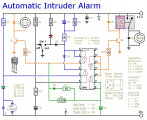 This circuit features automatic Exit/Entry delays, timed Bell Cut-off and System Reset. It will accommodate the usual normally-closed input devices (Magnetic Reed contacts, Micro Switches, Foil Tape and PIRs). And - with a simple modification - a normally-open trigger may be added....
[read more]
This circuit features automatic Exit/Entry delays, timed Bell Cut-off and System Reset. It will accommodate the usual normally-closed input devices (Magnetic Reed contacts, Micro Switches, Foil Tape and PIRs). And - with a simple modification - a normally-open trigger may be added....
[read more]
 This circuit features automatic Exit/Entry delays, timed Bell Cut-off and System Reset. It has provision for normally-open and normally-closed switches and will accommodate the usual input devices (Pressure Mats, Magnetic Reed contacts, Foil Tape, PIRs and Inertia Sensors)....
[read more]
This circuit features automatic Exit/Entry delays, timed Bell Cut-off and System Reset. It has provision for normally-open and normally-closed switches and will accommodate the usual input devices (Pressure Mats, Magnetic Reed contacts, Foil Tape, PIRs and Inertia Sensors)....
[read more]
 The circuit features automatic Exit and Entry delays, timed Bell Cut-off and System Reset. It has provision for normally-open and normally-closed switches and will suit the usual input devices (Pressure Mats, Magnetic Reed contacts, Foil Tape, PIRs and Inertia Sensors)....
[read more]
The circuit features automatic Exit and Entry delays, timed Bell Cut-off and System Reset. It has provision for normally-open and normally-closed switches and will suit the usual input devices (Pressure Mats, Magnetic Reed contacts, Foil Tape, PIRs and Inertia Sensors)....
[read more]
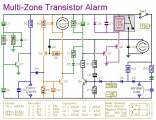 This transistor based alarm features automatic Exit and Entry delays - together with a timed Bell Cut-off and system Reset. Along with the Exit/Entry zone - the basic alarm board has one Instant Zone. This will be adequate in many situations. However - the modular design means that it's easy to add as many zones as you like to the system. Details of a Four-Zone expansion module are provided....
[read more]
This transistor based alarm features automatic Exit and Entry delays - together with a timed Bell Cut-off and system Reset. Along with the Exit/Entry zone - the basic alarm board has one Instant Zone. This will be adequate in many situations. However - the modular design means that it's easy to add as many zones as you like to the system. Details of a Four-Zone expansion module are provided....
[read more]
 This is a simple SCR based burglar alarm circuit. Its features include automatic Exit and Entry delays - together with a timed Bell Cut-off and Reset. The basic alarm has a single zone. This will be adequate in many situations. However - the modular design means that you can add as many zones as you like to the system. Details of a Four-Zone expansion module are provided....
[read more]
This is a simple SCR based burglar alarm circuit. Its features include automatic Exit and Entry delays - together with a timed Bell Cut-off and Reset. The basic alarm has a single zone. This will be adequate in many situations. However - the modular design means that you can add as many zones as you like to the system. Details of a Four-Zone expansion module are provided....
[read more]
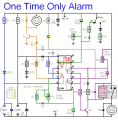 When this alarm is activated its Siren will sound once - for up to 20-minutes. Then it will switch off and remain off. The basic circuit has a single zone with independently adjustable Exit and Entry delays. This will be adequate in many situations. However, there's also a range of Expansion Modules. These will allow you to add any number of Instant Zones, Tamper Zones and Personal Attack Zones to your system....
[read more]
When this alarm is activated its Siren will sound once - for up to 20-minutes. Then it will switch off and remain off. The basic circuit has a single zone with independently adjustable Exit and Entry delays. This will be adequate in many situations. However, there's also a range of Expansion Modules. These will allow you to add any number of Instant Zones, Tamper Zones and Personal Attack Zones to your system....
[read more]
 This circuit features automatic Exit and Entry delays and a timed Bell Cut-off. It has provision for both normally-closed and normally-open contacts, and a 24-hour Personal Attack/Tamper zone. By using the Expansion Modules, you can add as many zones as you require; some or all of which may be the inertia (shock) sensor type....
[read more]
This circuit features automatic Exit and Entry delays and a timed Bell Cut-off. It has provision for both normally-closed and normally-open contacts, and a 24-hour Personal Attack/Tamper zone. By using the Expansion Modules, you can add as many zones as you require; some or all of which may be the inertia (shock) sensor type....
[read more]
 This two-zone alarm has automatic exit, entry and siren cut-off timers. It was developed for the Beginner's Guide To Cmos Timers. So it has a particularly detailed circuit description. There's an optional One-Time-Only module. It will force the siren to switch off after the first ten minutes - and prevent the alarm from activating a second time....
[read more]
This two-zone alarm has automatic exit, entry and siren cut-off timers. It was developed for the Beginner's Guide To Cmos Timers. So it has a particularly detailed circuit description. There's an optional One-Time-Only module. It will force the siren to switch off after the first ten minutes - and prevent the alarm from activating a second time....
[read more]
 This circuit, enclosed in a small plastic box, can be placed into a bag or handbag. A small magnet is placed close to the reed switch and connected to the hand or the clothes of the person carrying the bag by means of a tiny cord....
[read more]
This circuit, enclosed in a small plastic box, can be placed into a bag or handbag. A small magnet is placed close to the reed switch and connected to the hand or the clothes of the person carrying the bag by means of a tiny cord....
[read more]
 This circuit emits a beep and/or illuminates a LED when someone touches the door-handle from outside....
[read more]
This circuit emits a beep and/or illuminates a LED when someone touches the door-handle from outside....
[read more]
 This circuit is permanently plugged into a mains socket and NI-CD batteries are trickle-charged. When a power outage occurs, the lamp automatically illuminates. Instead of illuminating a lamp, an alarm sounder can be chosen....
[read more]
This circuit is permanently plugged into a mains socket and NI-CD batteries are trickle-charged. When a power outage occurs, the lamp automatically illuminates. Instead of illuminating a lamp, an alarm sounder can be chosen....
[read more]